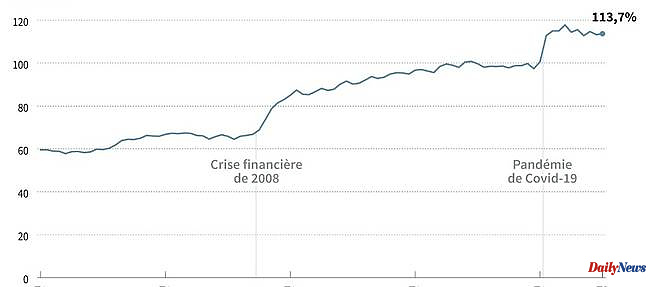A public debt of around 3,000 billion euros: the National Institute of Statistics (Insee) reveals on Tuesday the level of indebtedness of the country, inflated by the crises, as well as the extent of the public deficit.
After soaring in 2020 due to the health crisis, the public debt ratio began to decline slightly in 2021 thanks to a rebound in growth, reaching 112.8% of gross domestic product (GDP).
For 2022, the government is counting on a further decline, to 111.6%, while the public deficit would shrink to 5% of GDP, against 6.5% in 2021, against a backdrop of slowing growth to 2.6%. % last year.
According to the newspaper Les Echos, the public deficit should finally reach 4.8% of GDP, "or even less", better than the official objective, while the public debt would not exceed the unprecedented threshold of 3,000 billion euros.
The Ministry of Economy and Finance did not confirm these figures.
In any case, these levels remain much higher than those which prevailed before the health and then energy crises, when the debt reached less than 100% of GDP and the public deficit stood at 3% of GDP in 2019.
Partial unemployment, guaranteed loans to businesses, exceptional checks, rebates at the pump... With the "whatever the cost", the State has indeed spent lavishly in order to protect households and businesses from the shock of the pandemic and then consequences of the war in Ukraine, including galloping inflation.
Record or not, this surge in indebtedness weighs on public finances by considerably increasing the debt burden.
“The annual cost of interest on the loan is the second budgetary item of the State” behind National Education, alerts Lisa Thomas-Darbois, head of the economy and state action center at the Institut Montaigne.
The addition is all the more salty as the interest rates at which the State borrows on the markets have risen sharply with inflation. And to make matters worse, a tenth of the French debt is indexed to inflation, which increases its cost all the more.
The burden of public borrowings increased by 13 billion euros in one year, to more than 51 billion in 2022, while the rates of 10-year French bonds rebounded sharply around 3% after years of very low rates. low or even negative.
More than an absolute figure, it is above all the evolution of the debt ratio in relation to GDP which is particularly scrutinized on the markets.
At this stage, investors are not worried. French debt is considered a safe asset and the difference (“spread”) with Germany's interest rates, which is the benchmark in the EU, has not widened significantly.
To restore public finances, the government is mainly relying on a faster rise in GDP than that of expenditure, which would be the subject of "several billion euros in savings" in the 2024 finance project (PLF), according to the Minister of Economy and Finance Bruno Le Maire.
Growth is anticipated by the executive at 1% in 2023, a forecast higher than that of the Banque de France, the OECD or the International Monetary Fund (IMF).
However, the Court of Auditors sounded the alarm in early March, expressing concern about the government's slowness in restoring public finances.
She estimated that the deficit would be absorbed too late, falling below the European limit of 3% of GDP only in 2027, while the debt would remain more or less at its current level, at 110.9%. The financial magistrates had even pointed to the risk that it would widen.
“We assume that we have to restore our public finances and we assume not to do it in a brutal way”, retorted the Minister in charge of Public Accounts, Gabriel Attal, which would give “more unemployment, more taxes and more of debt".
The government plans to present its new stability program around mid-April setting the trajectory of public finances for the coming years.
03/28/2023 07:28:10 - Paris (AFP) - © 2023 AFP












